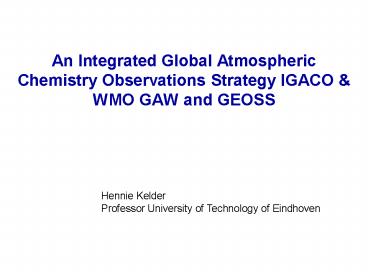An Integrated Global Atmospheric Chemistry Observations Strategy IGACO - PowerPoint PPT Presentation
1 / 11
Title:
An Integrated Global Atmospheric Chemistry Observations Strategy IGACO
Description:
A Consortium of 13 Partners Formed in 1999 with a secretariat that rotates ... Environmental Pollution And Atmospheric Chemistry(EPAC) WMO/GAW Secretariat. AREP ... – PowerPoint PPT presentation
Number of Views:39
Avg rating:3.0/5.0
Title: An Integrated Global Atmospheric Chemistry Observations Strategy IGACO
1
An Integrated Global Atmospheric Chemistry
Observations Strategy IGACO WMO GAW and GEOSS
Hennie Kelder Professor University of Technology
of Eindhoven
2
What Is IGOS?A Consortium of 13 Partners Formed
in 1999 with a secretariat that rotates lead
every 2 years. They meet regularily with CEOS
- The IGOS Partners include the
- Global observing systems
- Global Climate Observing System (GCOS)
- Global Ocean Observing System (GOOS)
- Global Observing System (GOS) of the WMO
- Global Atmospheric Watch(GAW) of the WMO
- Global Terrestrial Observing System (GTOS)
- Sponsors of the global observing systems
- World Meteorological Organization (WMO)
- U.N. Educational, Scientific, and Cultural
Organization (UNESCO) - U.N. Environment Programme (UNEP)
- Intergovernmental Oceanographic Organization
(IOC) - International Council for Science (ICSU)
- Food and Agriculture Organization (FAO)
- Committee on Earth Observation Satellites( CEOS)
- includes all national and regional government
agencies with an Earth observing satellite system - Global change research programs
- International Geosphere-Biosphere Programme
(IGBP) - World Climate Research Programme (WCRP)
3
Integrated Global Observing Strategy (IGOS)
Partnership
- Themes
- Ocean
- Global Carbon Cycle (IGCO)
- Global Water Cycle (IGWCO)
- Geo-Hazards
- Atmospheric Chemistry (IGACO)
- Coastal (incl. Coral-Reef)
- Land
4
Integrated Global Atmospheric Chemistry
Observation (IGACO) System
- Objectives
- To ensure accurate, comprehensive global
observations of key atmospheric gases and
aerosols - To establish a system for integrating
ground-based, in situ and satellite observations
using atmospheric models - To make the integrated observations accessible to
users.
An IGOS theme implemented by WMO
Observations
Satellite
IGACO System
An international process Panel of 19 experts
from 12 countries and independent reviewers
from 7 countries.
Aircraft
Products
NO2
Ground-based
Links to Space agencies, WCRP, GCOS, IGBP, IGOS
themes Lbarrie_at_wmo.int Joerg.Langen_at_esa.int
Ozone Depletion
Climate
Air Quality
5
IGACO TARGET VARIABLE LIST
6
The Role Of The World Meteorological Organization
(WMO)
- As the lead agency designated by IGOS to
implement IGACO, WMO shall use its unique
international experience, programmes and
partnerships to build a generally accepted global
plan and to promote implementation through
bottom-up research efforts at the national and
regional level. - IGACO builds on GAW, other WMO programmes and
partnerships. It bridges surface-based, aircraft
and satellite observations to the weather
forecast and modelling research community.
7
WMO GAW What is it?
- The Global Atmosphere Watch programme of WMO
- Established in 1989 by merging the Global Ozone
Observing System (GO3OS) and Background
Monitoring of Air Pollution (BAPMoN) programmes - Coordinated by the Environment Division of WMOs
Atmospheric Research and Environment Programme
(AREP) department under the Commission for
Atmospheric Science (CAS) and its Working Group
on Environmental Pollution and Atmospheric
Chemistry.
8
The GAW Mission
- Systematic Global Monitoring Of Chemical
Composition of the Atmosphere. - Analysis and Assessment in Support of
International Conventions. - Development Of Air Pollution and Climate
Predictive Capability
9
WMO GAW Monitoring Components
10
Geo summit Cape Town, November 2007 accepted
- WMO
11
Recommendations from IGACO, WMO GAW, GEO
Summit Short term Planning and initiation of a
coordinated satellite system compromising both
LEO and GEO instruments complemented by
non-satellite measurement network for air
quality and climate Beyond 2014 Provide an
operational network of the appropriate
combination of LEO and GEO satellites with
adequate coverage and time resolution TROPOMI is
fully in line with the recommendations of
IGACO, WMO and GEOSS to be implemented as LEO
component and as a precursor for sentinel 5 for
atmospheric chemistry































